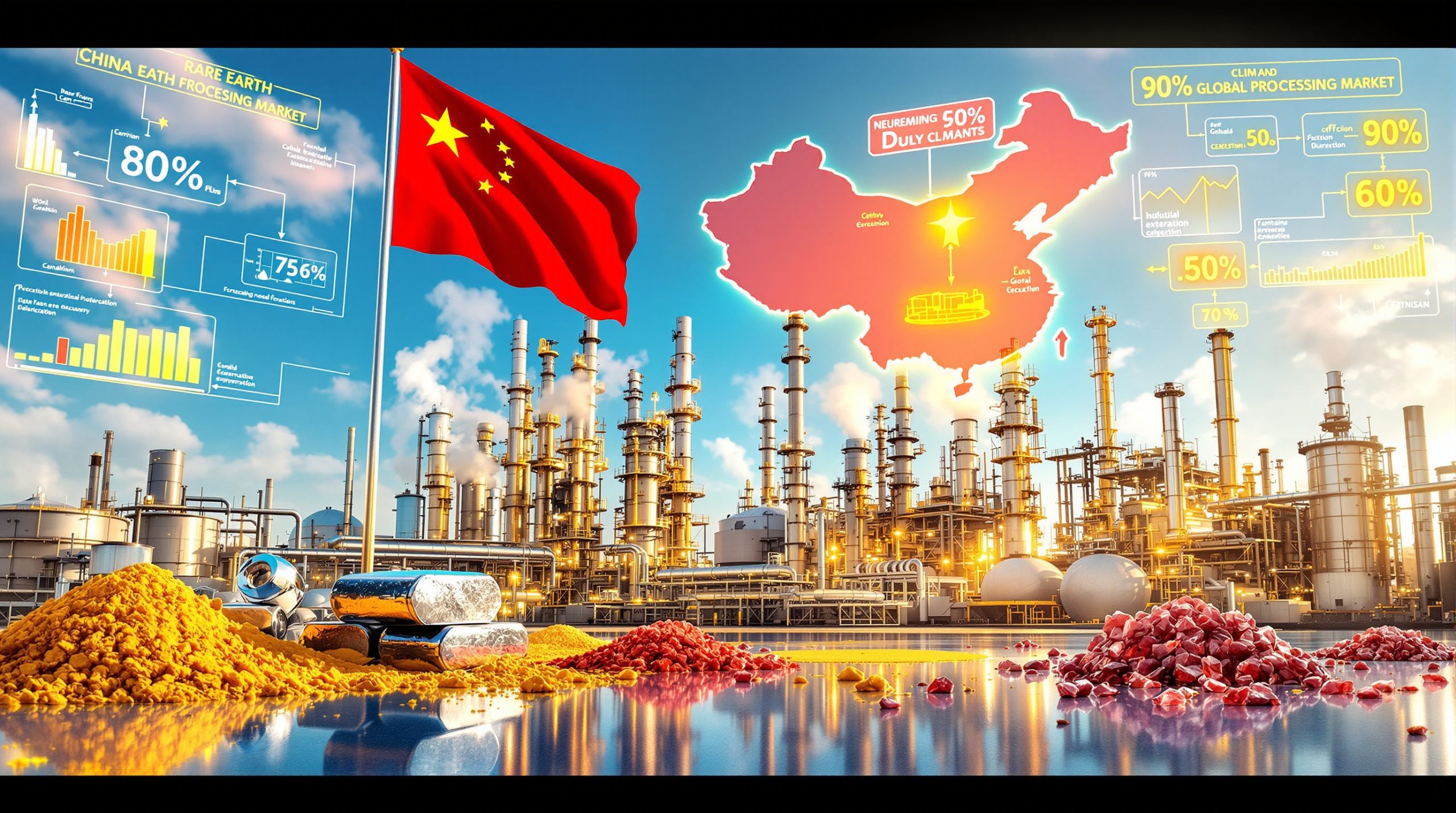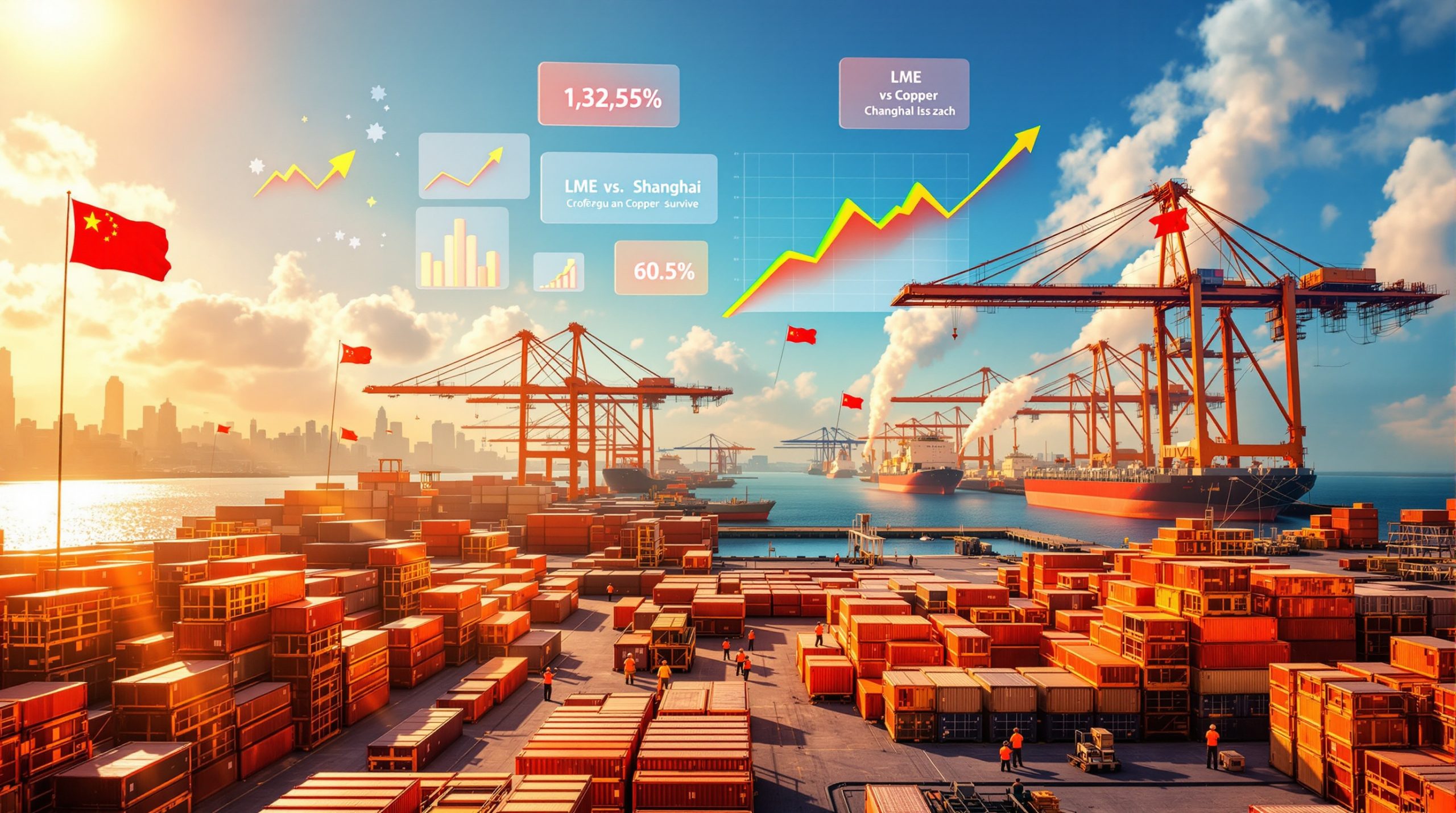What Makes China's Rare Earth Processing Monopoly Different From Other Resource Monopolies?
China's grip on rare earth processing represents a unique form of industrial dominance that extends far beyond traditional resource control. Unlike oil or copper monopolies that rely primarily on geological advantages, Beijing's rare earth supremacy stems from a calculated four-decade strategy targeting the most technically challenging and economically valuable segments of the supply chain.
The fundamental distinction lies in understanding where value creation occurs within rare earth supply chains. Raw ore extraction represents the lowest-margin activity, while chemical separation, purification, and downstream manufacturing capture the majority of economic rents. This strategic focus on processing rather than mining has enabled China to maintain control over 90% of global rare earth element processing despite controlling only 60-70% of mining operations worldwide.
Furthermore, this dominance directly impacts critical minerals & energy security considerations for nations seeking to reduce their dependence on Chinese supply chains.
Key Statistics:
• China processes 90% of global rare earth elements despite controlling only 60-70% of mining
• Heavy rare earth processing approaches 100% Chinese control
• Processing margins are 5-10x higher than raw mining operations
The Processing vs. Mining Distinction That Changed Everything
The critical insight lies in understanding where value creation occurs within rare earth supply chains. Raw ore extraction represents the lowest-margin activity, while chemical separation, purification, and downstream manufacturing capture the majority of economic rents.
Value Chain Breakdown:
| Stage | Global Market Share (China) | Profit Margins |
|---|---|---|
| Mining | 60-70% | 10-15% |
| Chemical Processing | 90% | 40-60% |
| Magnet Production | 85% | 50-70% |
| Component Manufacturing | 80% | 60-80% |
This value distribution explains why China's strategy focused on capturing the chemical separation and downstream manufacturing stages rather than simply controlling ore deposits. Rare earth ores contain multiple lanthanides and actinides in chemically bound forms requiring multi-stage solvent extraction to separate individual elements to commercial purity.
This separation process represents the technical bottleneck that China has systematically mastered and monopolised. The MP Materials Mountain Pass facility in California exemplifies this distinction perfectly.
The site maintains significant ore reserves and mining capacity but historically relied on Chinese processors for refined rare earth compounds, demonstrating that mining capacity alone does not confer supply chain control.
How Did China Execute Its 40-Year Rare Earth Strategy?
Beijing's approach combined five interconnected mechanisms that created compounding advantages over time, making it increasingly difficult for competitors to challenge Chinese dominance. This systems-level strategy suggests that attacking any single mechanism would prove insufficient to break Chinese control because multiple complementary levers reinforce each other.
State-Backed Financial Engineering and Long-Term Capital Deployment
China leveraged government-backed credit facilities, subsidised infrastructure, and patient capital to maintain production during periods when Western competitors faced financial pressure. This approach allowed Chinese producers to operate at break-even or losses for extended periods, systematically driving international competitors out of the market.
Financial Advantages:
• Subsidised electricity rates 30-40% below market prices
• Government-backed loans with below-market interest rates
• Tax incentives reducing effective corporate tax rates to 10-15%
• State-owned enterprise investment during unprofitable periods
The concept of patient capital deployed through state coordination represents a fundamentally different approach to industrial development compared to Western market-driven competition models. This long-horizon state coordination enabled Chinese producers to undercut Western competitors even when margins were razor-thin, forcing many global rivals to shut down permanently.
Technical Mastery of Solvent Extraction and Separation Processes
While Western companies focused on mining operations, China invested heavily in developing expertise in the complex chemical processes required to separate individual rare earth elements. This technical specialisation created knowledge barriers that proved difficult for other nations to replicate.
Technical Capabilities:
• Multi-stage solvent extraction systems handling 15+ different elements
• Precision impurity control achieving 99.9%+ purity levels
• Scaled separation facilities processing 50,000+ tonnes annually
• Proprietary process improvements reducing separation costs by 40-60%
China's particular advantage in processing ion-adsorption clay deposits deserves special attention. These Chinese geological formations permit simpler extraction than hard rock deposits, giving Chinese operations additional processing advantages beyond chemical engineering expertise.
Ion-adsorption ores can be processed using in-situ leaching techniques that require less energy and infrastructure than conventional hard rock mining and processing.
Why Environmental Regulations Became China's Competitive Advantage
During the 1980s-2000s, China's willingness to accept environmental externalities from rare earth processing created a significant cost advantage over Western competitors operating under stricter regulatory frameworks. This environmental regulatory arbitrage provided a critical 15-20 year window for China to build unassailable market position and technical expertise.
The Real Cost of Environmental Compliance in Rare Earth Processing
Rare earth separation generates substantial radioactive and chemical waste streams that require expensive treatment and disposal. The specific radiological profile of rare earth processing waste, particularly thorium and uranium-bearing residues, creates complex disposal challenges that Western facilities faced under stringent regulatory oversight while Chinese operations initially externalised these costs.
Environmental Cost Differentials:
• Waste treatment: $50-200 per tonne (China) vs. $500-2000 per tonne (Western countries)
• Regulatory compliance: 5-10% of operating costs vs. 25-40%
• Site remediation reserves: Minimal vs. $200-800 million per facility
"The environmental arbitrage wasn't sustainable long-term, but it provided China with a 15-20 year window to build unassailable market position and technical expertise."
The US Mountain Pass facility closure in the 1990s directly correlates with stringent environmental compliance costs, representing the clearest Western example of environmental regulation forcing market exit. Western facilities faced cleanup costs of $100-500 million per plant, while Chinese operations initially avoided such expenditures entirely.
The Australian Lynas operation faced Malaysian regulatory resistance to its Kuantan separation facility due to environmental concerns, demonstrating that environmental compliance cost differentials persist even today.
How China Created Manufacturing Ecosystem Lock-In Effects
Beyond processing dominance, China systematically attracted downstream manufacturers to co-locate near rare earth supply sources, creating powerful network effects that increased switching costs for global supply chains. This geographic clustering created self-reinforcing advantages that made rebuilding supply chains outside China exponentially more difficult.
The Magnet Manufacturing Migration to China
As Chinese rare earth processing capacity expanded, magnet manufacturers relocated operations to access lower-cost feedstock. This geographic clustering created self-reinforcing advantages that made rebuilding supply chains outside China exponentially more difficult.
Manufacturing Concentration:
• 85% of permanent magnet production located within 500km of Chinese processing facilities
• Supply chain integration reducing logistics costs by 20-30%
• Technical collaboration between processors and manufacturers
• Skilled workforce development in specialised rare earth applications
Modern neodymium-iron-boron (NdFeB) magnet manufacturing involves close coordination with rare earth processing. Raw material specifications, just-in-time delivery, and technical collaboration on alloy compositions all benefit from proximity.
The technical requirements of magnet manufacturing justify geographic clustering and create path dependence where individual rational decisions at the firm level aggregate into collective dependency at the industry level.
The emergence of magnet manufacturing clusters in Liaoning, Inner Mongolia, and Shandong provinces directly followed rare earth processing capacity expansion in these regions. International magnet producers including Japanese, European, and US firms relocated to China during the 2000s-2010s period, creating the manufacturing ecosystem that now dominates global production.
What Role Do Export Controls Play in Maintaining Chinese Dominance?
Following the 2014 WTO ruling against Chinese export quotas, Beijing shifted toward more sophisticated control mechanisms that maintain strategic leverage while complying with international trade rules. The strategic shift from quantity-based quotas to technology-transfer and dual-use controls represents sophisticated regulatory innovation that maintains leverage while reducing legal vulnerability to WTO challenge.
Modern Export Control Architecture and Technology Transfer Restrictions
China's current approach focuses on controlling technology transfer, production equipment exports, and dual-use applications rather than raw material quotas. The 2020 Export Control Law provides the statutory basis for these modern controls, enabling selective export approvals based on geopolitical considerations rather than purely commercial principles.
Current Control Mechanisms:
• Export licensing for separation technology and equipment
• Restrictions on technical personnel working for foreign competitors
• Dual-use technology controls covering military applications
• Production capacity limitations through domestic industry consolidation
The classification of rare earth separation processes as sensitive or strategic under Chinese export controls enables China to selectively approve or deny technology transfers. Solvent extraction equipment, precipitation systems, and specialised separation technology specifications fall under export licensing requirements that can be applied discriminatorily based on strategic considerations.
After the WTO ended China's export quota system, Beijing reorganised the industry into a few large state-backed groups and introduced comprehensive export-control laws. Licensing requirements, production caps, and dual-use technology restrictions gave China durable geopolitical leverage over the rare earth supply chain without violating international trade rules.
Why Western Diversification Efforts Face Structural Challenges
Attempts to rebuild rare earth processing capacity outside China encounter multiple interconnected barriers that make rapid diversification extremely difficult and expensive. These diversification barriers are interconnected rather than isolated, creating multiplicative rather than additive challenges for competitors.
The implications of mining industry evolution suggest that technological advances alone may not be sufficient to overcome China's processing advantages.
The Capital Requirements for Full Supply Chain Reconstruction
Building competitive rare earth processing requires integrated facilities spanning mining through finished products, with capital requirements often exceeding $2-5 billion per project. The total integration timeline of 8-12 years represents significant execution risk and capital lock-up that few private investors can sustain without government support.
Investment Requirements by Stage:
| Facility Type | Capital Cost | Timeline | Key Challenges |
|---|---|---|---|
| Mining Operation | $200-800M | 3-5 years | Permitting, infrastructure |
| Processing Plant | $800-2000M | 5-7 years | Technology, workforce |
| Magnet Facility | $300-800M | 2-4 years | Market access, competition |
| Full Integration | $2-5B | 8-12 years | Financing, coordination |
The capital costs alone would be surmountable if time horizons were unlimited and technology were freely available, but the combination of high capital, long timelines, limited workforce availability, and Chinese technical advantages creates barriers that compound rather than simply add together.
Technical Workforce and Knowledge Transfer Barriers
Rare earth processing requires specialised expertise that takes decades to develop. China's workforce advantages create significant barriers for new entrants attempting to build competitive operations.
Once a solvent-extraction plant shuts down, its skilled workforce scatters and its permits lapse, making rebuilding exponentially more difficult than initial construction.
Workforce Challenges:
• 15-20 year learning curve for senior process engineers
• Limited availability of experienced personnel outside China
• Technology transfer restrictions limiting knowledge sharing
• University programmes producing <100 rare earth specialists annually (globally)
The switching cost concept extends beyond facility switching to include ecosystem switching. Rebuilding does not mean simply duplicating Chinese infrastructure but creating entirely new technical ecosystems including workforce development, supplier networks, and customer relationships.
What Does China's Rare Earth Monopoly Mean for Global Supply Chains?
Chinese dominance creates systemic vulnerabilities for industries dependent on rare earth elements, particularly in clean energy, defence, and advanced manufacturing sectors. The global economy is not short of rare earth ore deposits, but rather short of non-Chinese refining and magnet manufacturing capacity.
Strategic Vulnerabilities in Critical Technology Supply Chains
Industries requiring rare earth inputs face potential supply disruptions that could significantly impact production and pricing across multiple sectors. The bottleneck has shifted from mining raw ore to chemically separating rare earths, exactly where China built its fortress of technical and economic control.
Affected Industries:
• Electric vehicle motors (requiring 1-3kg rare earths per vehicle)
• Wind turbine generators (200-600kg per MW capacity)
• Defence systems (guidance systems, communications equipment)
• Consumer electronics (smartphones, computers, displays)
The path dependence created by decades of supply chain concentration in China means that diversification requires rebuilding not just individual facilities, but entire industrial ecosystems. This systematic vulnerability affects national security planning across multiple developed nations.
Furthermore, decarbonisation in mining efforts worldwide depend heavily on rare earth elements, making China's monopoly particularly significant for global climate goals.
How Are Other Countries Responding to Chinese Rare Earth Dominance?
Western governments and companies have launched multiple initiatives aimed at reducing dependence on Chinese rare earth processing, though these efforts face significant technical and economic challenges. Diversification is possible only if countries outside China fund full value chains from mines through magnets while accepting higher costs and government support.
US and European Rare Earth Independence Initiatives
Government programmes in the United States, Europe, and Australia focus on rebuilding domestic processing capacity through subsidies, strategic partnerships, and public-private cooperation. However, projects that stop at mining or mixed carbonate production miss the strategic value that lies in separation, magnet metals, and finished magnets.
Major Diversification Projects:
• MP Materials (California): $700M investment in US processing capacity
• Lynas Rare Earths (Australia/Malaysia): Expanding separation facilities
• European Raw Materials Alliance: €1.2B investment commitment
• Canada Critical Minerals Strategy: $3.8B funding allocation
These diversification efforts require sustained government support, massive capital investment, and acceptance of higher costs for strategic security benefits. The broad direction aligns with independent assessments that China's rare earth processing monopoly is rooted in process capacity rather than geological advantage.
Additionally, geopolitical tensions such as US-China trade impacts have accelerated Western efforts to establish alternative supply chains.
The Economics of Non-Chinese Rare Earth Processing
Alternative supply chains face 40-80% higher costs compared to Chinese operations, requiring sustained government support or premium pricing to achieve commercial viability. The cost differential reflects not just labour and environmental compliance costs, but also the accumulated advantages of Chinese technical expertise and integrated supply chains.
Cost Comparison Analysis:
• Processing costs: $8-15/kg (China) vs. $15-25/kg (Western facilities)
• Environmental compliance: Additional $5-12/kg outside China
• Labour costs: 3-5x higher in developed countries
• Infrastructure: Requires $200-500M additional investment per facility
What Future Scenarios Could Challenge China's Rare Earth Control?
Several technological and geopolitical developments could potentially alter the current rare earth landscape, though significant changes would likely require decades to implement. The timeline for meaningful diversification extends well beyond typical business planning horizons.
Recycling Technologies and Circular Economy Solutions
Advanced recycling processes could reduce dependence on primary rare earth production by recovering elements from end-of-life products, though current recycling rates remain below 1% for most rare earths. The technical challenges of rare earth recycling mirror those of primary processing, requiring similar chemical separation expertise.
Recycling Potential:
• Electronic waste contains 10-15% of annual rare earth demand
• Magnet recycling could supply 20-30% of neodymium requirements
• Technology improvements needed to achieve 80%+ recovery rates
• Economic viability requires rare earth prices 2-3x current levels
Alternative Material Development and Substitution Strategies
Research into rare earth-free technologies could reduce demand for certain applications, though complete substitution remains technically challenging for most high-performance applications. The performance gaps between rare earth and alternative materials remain substantial for critical applications.
Substitution Possibilities:
• Ferrite magnets for low-performance applications (50% weaker than rare earth magnets)
• Alternative permanent magnet materials (still in research phase)
• Electromagnetic alternatives for some motor applications
• Complete redesign of systems to eliminate rare earth requirements
The development timeline for commercially viable alternatives typically exceeds 10-15 years, while the performance trade-offs often make substitution economically unattractive even when technically possible.
Key Takeaways for Understanding China's Rare Earth Monopoly
China's rare earth processing monopoly represents a masterclass in strategic industrial policy that combined patient capital, technical expertise, environmental arbitrage, and ecosystem development to create nearly insurmountable competitive advantages. This was not an accident of geology, but the result of a deliberate, decades-long strategy targeting the most valuable segments of the supply chain.
The current monopoly is reinforced by China's resource strategies across multiple commodity sectors, creating synergies that strengthen their position in rare earths.
Critical Success Factors:
• Focus on high-value processing rather than low-margin mining
• Long-term investment horizons spanning multiple economic cycles
• Integration of upstream and downstream supply chain segments
• Systematic development of technical expertise and specialised workforce
• Strategic use of environmental and regulatory differences
The path to diversification requires sustained government support, massive capital investment, and acceptance of higher costs for strategic security benefits. While alternative supply chains are technically feasible, they will require decades to achieve meaningful scale and cost competitiveness.
Recent developments suggest that China plans to restrict rare earth shipments to US military contractors, highlighting the strategic importance of this monopoly position.
Moreover, China's approach to maintaining its rare earth dominance continues to evolve as other nations attempt to establish alternative supply chains.
Understanding China's rare earth processing monopoly reveals how industrial policy, executed with patience and strategic vision, can create enduring competitive advantages that reshape global supply chains. The lesson for policymakers and investors is clear: the real strategic and economic value lies not in controlling resources, but in controlling the technical processes that transform raw materials into finished products.
This analysis draws from research examining China's industrial strategy development, USGS mineral commodity data, and case studies of rare earth supply chain development over the 1978-2025 period. Readers should note that rare earth market dynamics remain subject to ongoing technological, regulatory, and geopolitical changes that may alter future supply chain configurations.
Looking to Capitalise on Critical Minerals Investment Opportunities?
China's rare earth processing dominance demonstrates how control over strategic mineral supply chains can create extraordinary investment opportunities, particularly as Western nations accelerate diversification efforts with billions in government funding. Discovery Alert's proprietary Discovery IQ model delivers real-time notifications on significant ASX mineral discoveries across critical commodities, empowering subscribers to identify actionable opportunities before broader market awareness develops. Begin your 30-day free trial today and position yourself ahead of this evolving strategic landscape.




